Wood Stove Floor Protector: Everything You Need to Know
- November 3, 2023
- 1 comment
Wood stoves are like cozy campfires for your home, giving off toasty warmth and old-fashioned charm. But just like a campfire needs a circle of rocks to keep it safe, your wood stove needs its own protector to keep your floor safe. That’s where hearth pads come in, acting like a superhero shield. Some keep away flying sparks that might try to escape, while others stop the floor from getting too hot. Not only do these pads keep your home safe, but they also look good, adding a special touch that makes your stove and room look even better.
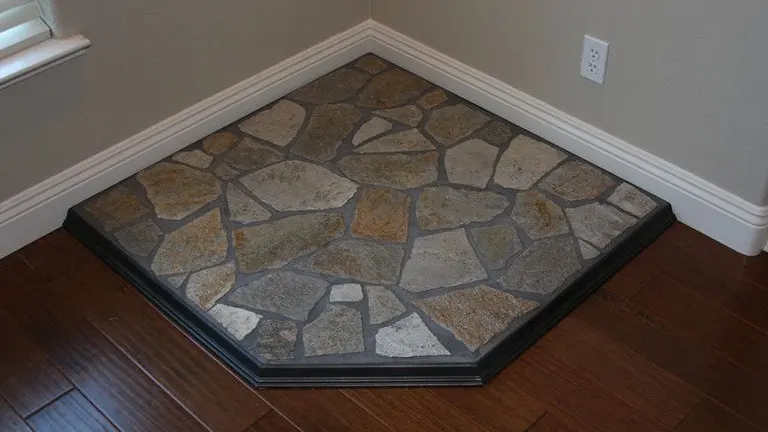
Key Safety Measures for Wood Stove Floor Protection and Clearance Requirements
Understanding the specific requirements for your wood stove’s floor protection is crucial for safety and efficiency. There are two main types of protection: ember and thermal.
Ember protection involves using a non-combustible material that’s at least 0.018 inches thick, equivalent to a 26-gauge (or roughly 0.45mm) sheet of metal. This is designed to catch and stop burning embers that might fall out of the stove.
For stoves that require thermal protection to keep a combustible floor from overheating, you’ll see an “R-value” listed—this is a measure of the material’s insulation properties. Achieving the necessary R-value can be done in various ways, using different materials. It’s best to have a detailed conversation with your dealer to figure out the most suitable material for your specific stove and to ensure you meet the required safety standards.

When it comes to the actual floor protection or hearth, the minimum requirements are at least 16 inches of protection in front of the stove in the United States (18 inches in Canada), and a minimum of 6 inches to the sides and back in the U.S. (8 inches in Canada).
It’s essential not to mix up these floor protection standards with the clearance requirements for other combustibles like walls next to or behind the stove. Each stove model will have its specific clearances detailed in the product literature and the owner’s manual. These clearances are there to prevent the stove’s heat from igniting nearby combustible materials and must be strictly followed.
However, when it comes to both floor protection and clearances to combustibles, a good rule of thumb is that more is better. If the minimum front hearth extension is 16 or 18 inches, considering extending it to 20 or 24 inches offers extra safety and peace of mind. Similarly, if the required clearance from the stove to a combustible wall is 8 inches, giving it a buffer and setting it 10 to 12 inches away is wise. Opting for more than the minimum requirement often means a safer installation, allowing you to enjoy the warmth of your wood stove without worry.
Why Do You Need a Wood Stove Floor Protector?
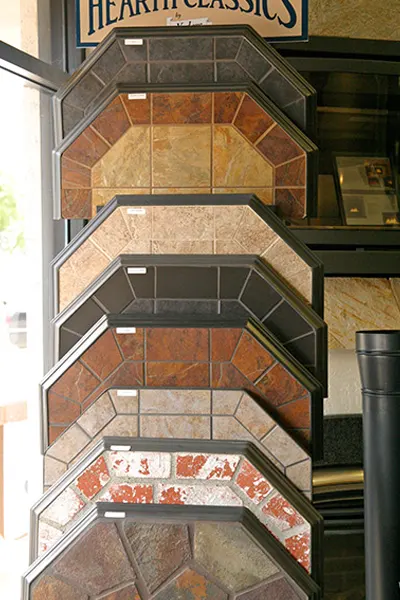
One might wonder about the necessity of a wood stove floor protector. The paramount reason lies in safety. When using a wood stove, there’s always the risk of embers, ash, or hot coals falling out, especially when opening the stove door. These stray materials have the potential to scorch or even damage the floor underneath. Additionally, many local building codes have mandated the installation of non-combustible floor protectors beneath wood stoves. This isn’t just a safety measure from a construction perspective; it’s also a point of consideration for insurance.
Some insurance policies might even stipulate the presence of such protectors as a requisite for coverage. Beyond these safety and regulatory considerations, there’s a more day-to-day reason for having a floor protector: to defend the floor from scratches, dings, or other damages. This could happen during routine activities like loading wood or cleaning the stove. But it’s not all about practicality; aesthetics play a role too. A judiciously chosen floor protector can accentuate the room’s decor, transforming the wood stove from a mere heating appliance to a captivating centerpiece.
Types of Wood Stove Floor Protectors
Tile and Stone
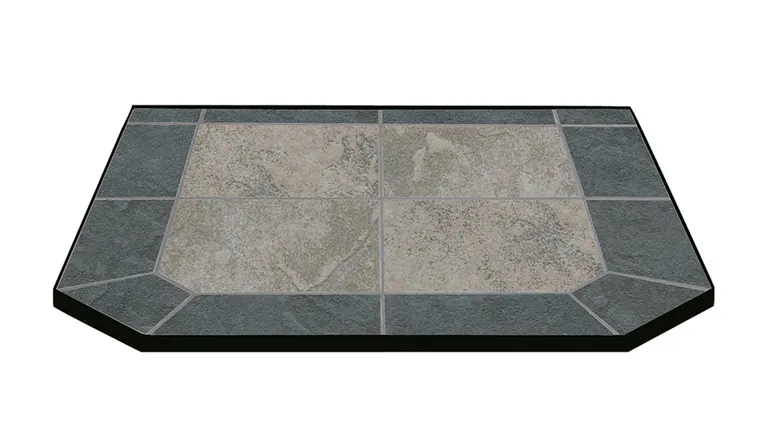
Among the top choices for wood stove floor protectors are ceramic tiles, slate, and natural stone. These materials are favored not only for their inherent non-combustible properties but also for the sheer aesthetic diversity they bring to the table. The vast palette of styles, textures, and colors they come in makes it easy for homeowners to find a match that resonates with their interior decor. Whether you prefer the earthy tones of slate or the polished finish of ceramic, these options promise both safety and elegance.
Metal
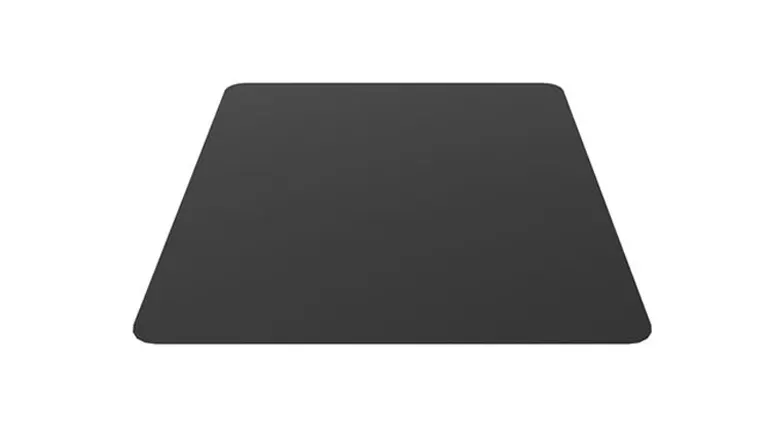
If you’re looking for something that screams contemporary, then metal pads or sheets might be right up your alley. With their sleek, minimalist appeal, they resonate particularly well with modern interior designs. Moreover, they offer a distinct industrial vibe, creating a bold statement. Metal protectors are not only about aesthetics; they are durable and effectively shield the floor from any stray embers or ash.
Glass and Tempered Glass
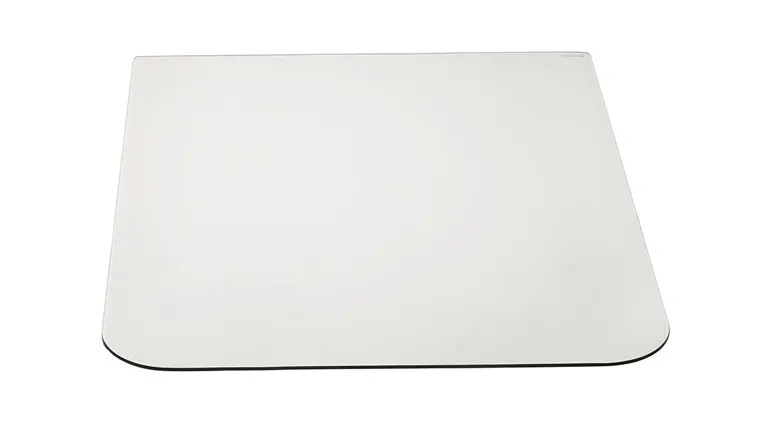
For those who lean towards an ultra-modern aesthetic, glass, especially tempered glass, presents an impeccable choice. What makes glass protectors stand out is their ability to offer protection without obstructing the beauty of the original floor. They act like an invisible shield, preserving the floor underneath while contributing a touch of sophistication to the space. Furthermore, tempered glass, given its treatment, is more resistant to thermal stress and potential damage from the heat of the stove.
Brick
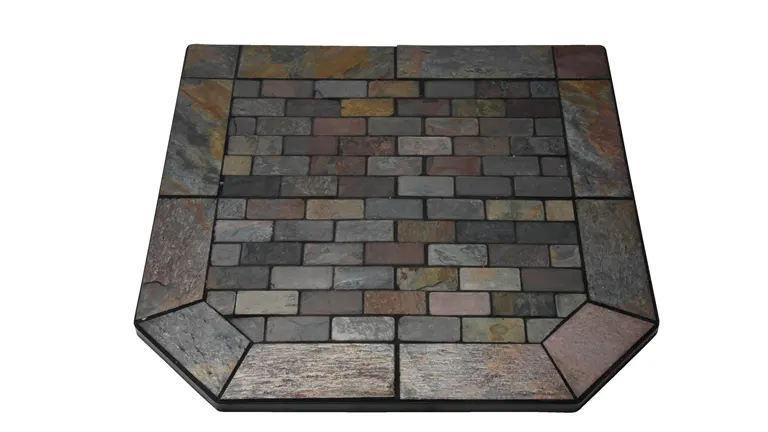
Venturing on the traditional side, brick is a time-honored choice for a floor protector. Known for its durability and classic appeal, brick offers an undeniable rustic charm. One of the advantages of brick is its versatility in design. Homeowners can play around with various laying patterns, from herringbone to basketweave, to create a custom look that is both functional and aesthetically pleasing.
Specific Installation Instructions
When installing a floor protector, the process will vary depending on the material chosen:
Tile or Brick
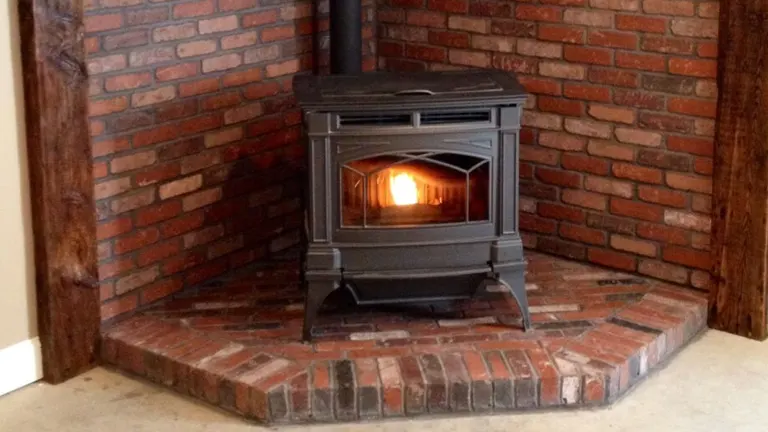
For installing tile or brick floor protectors, start by ensuring that the substrate is clean, level, and capable of supporting the weight. Use a cement backer board as a base if installing directly onto a wooden subfloor. Apply a layer of thin-set adhesive using a notched trowel, and then set the tiles or bricks firmly into the place. Make sure to leave appropriate space for grout between each piece, and after the adhesive has been set, apply grout to seal the gaps. It’s important to let the entire setup cure for the recommended time before placing the wood stove on top.
Metal Pad or Sheet
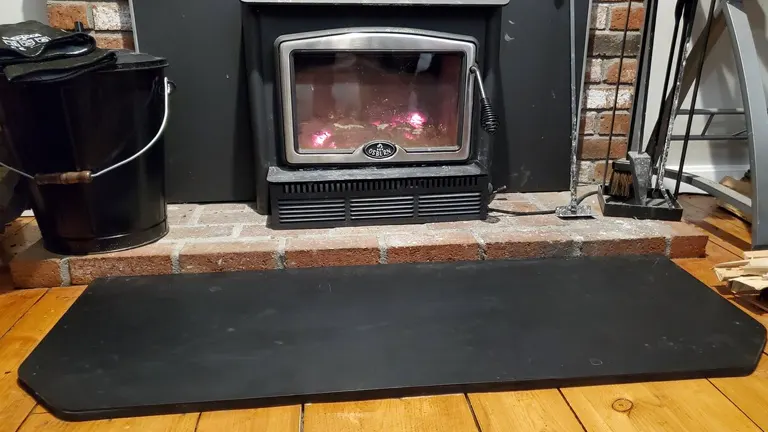
Metal floor protectors are often easier to install. Select a sheet of sufficient size and thickness, considering the stove’s weight and the heat it will generate. Some metal pads are designed to lay flat without attachment, while others may require securing to prevent slipping. If necessary, use appropriate fasteners to anchor the pad to the subfloor, making sure it does not cause a tripping hazard or interfere with the stove placement.
Enhanced Benefits of Wood Stove Floor Protectors
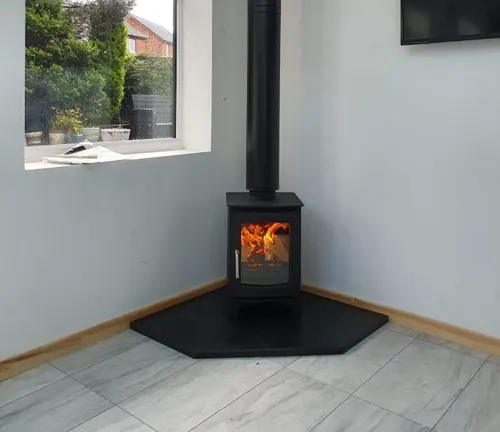
In addition to their primary function of safeguarding your floor from embers, ash, and heat, wood stove floor protectors bring a suite of secondary benefits to your home. Notably, they can play a significant role in reducing noise levels. The heavy, solid materials of protectors, such as stone or brick, naturally absorb sound, mitigating the clanks and clatters that occur when loading fuel into the stove or poking the fire. This contributes to a more tranquil and cozy atmosphere around your wood stove.
Furthermore, a well-designed floor protector can assist in improving heat distribution. Certain materials used in the construction of floor protectors, particularly metals, can reflect heat back into the room rather than allowing it to seep into the floor. This means your stove will work more efficiently, enhancing the warmth that permeates your living space.
Troubleshooting Common Issues
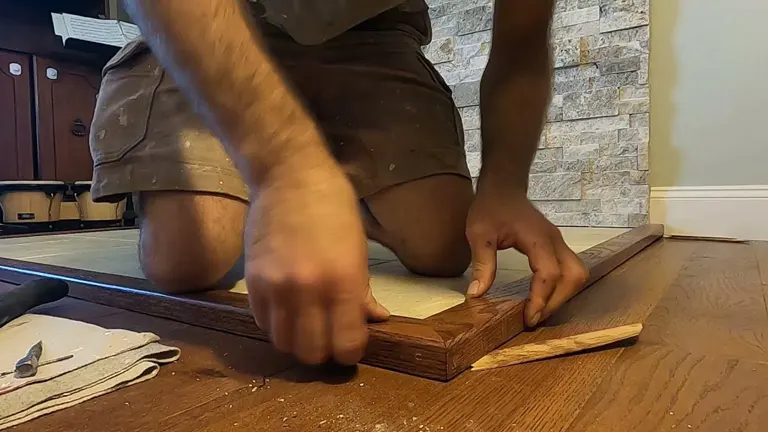
Even with diligent maintenance, issues may arise with wood stove floor protectors that require troubleshooting:
Cracked Tile: If a tile cracks, it’s important to replace it promptly to maintain the protective barrier. Remove the grout around the damaged tile using a grout saw or rotary tool. Then, carefully chisel out the broken tile and clean the area of old adhesive. Replace it with a new tile, re-apply adhesive, and grout around the new piece once it’s set.
Warped Metal Sheet: A warped metal floor protector may not only look unsightly but also could potentially create uneven heat distribution or stability issues for the wood stove. If minor, it might be possible to flatten the sheet using weight or gentle hammering. However, if the warping is significant, it is safer to replace the metal pad entirely.
Maintenance Tips: Regular maintenance includes sweeping or vacuuming away any debris, wiping down the surface with a suitable cleaner, and inspecting for any signs of wear or damage. Addressing issues promptly will ensure that your wood stove floor protector continues to offer both safety and efficiency in your home.
Hearth Pad Design
Your hearth pad serves as both a functional safety feature and a central design element for your wood stove area. By choosing the right materials and patterns, you can ensure that it complement your home’s aesthetic and meets your personal style. Here are a few ideas that blend functionality with design flair:
Herringbone Slate Hearth Pad
- Design Appeal: The herringbone pattern is timelessly elegant, providing a sophisticated backdrop for the rustic charm of a wood stove.
- Material Benefits: Slate is durable and naturally heat-resistant, ideal for the demands of a stove hearth.

Recessed Hearth Pad
- Design Appeal: A recessed design integrates the hearth into your floor, offering a minimalist, clean look that can make the room feel more spacious.
- Material Versatility: Choose from stone, brick, or tile to match your home’s decor while keeping the hearth flush with the surrounding flooring.
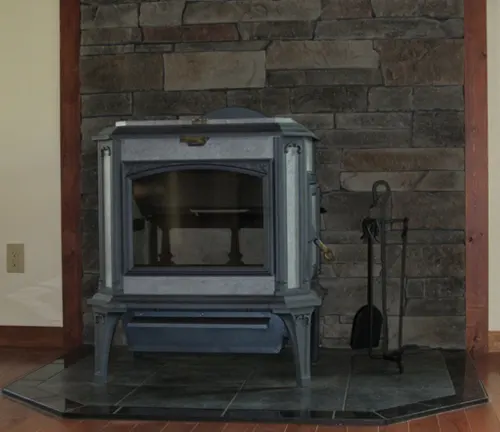
Geometric Tile Hearth Pad
- Design Appeal: Geometric shapes like hexagons or chevrons can inject a contemporary vibe into your space.
- Customization: Mix and match colors and finishes to create a focal point that draws the eye and reflects your personal style.
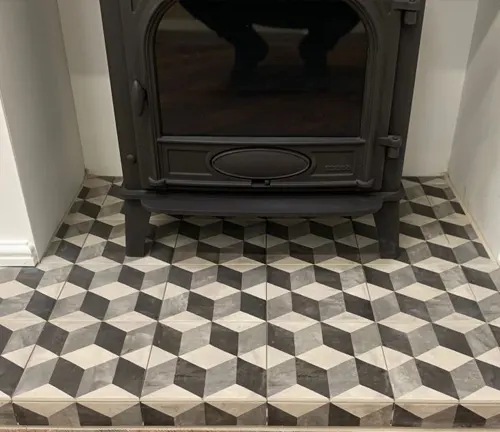
Mosaic Hearth Pad
- Design Appeal: A mosaic hearth pad is akin to a piece of art for your floor, offering limitless potential for color and pattern play.
- Creative Freedom: From intricate patterns to simple, bold designs, mosaics can be as detailed or as understated as you like.

A Step-by-Step Guide to Crafting Your Own Wood Stove Hearth Pad
Creating a bespoke hearth pad for your wood stove is not only a budget-friendly project but can also reflect your personal style. Typically, you can expect to spend around $150 to $250, although this may vary with your choice of materials.
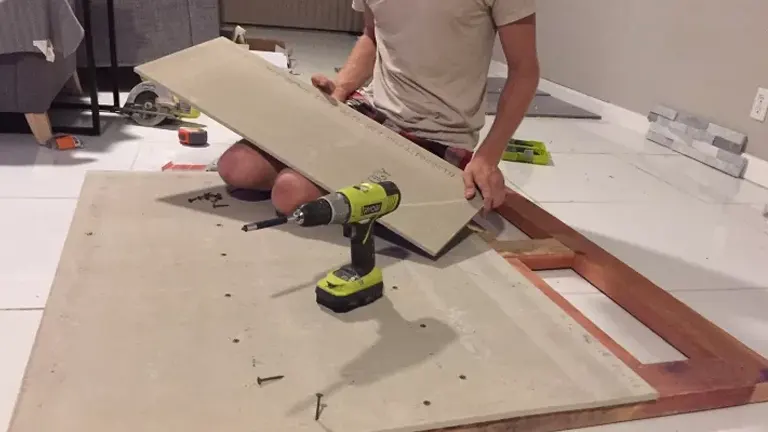
Here’s how you can approach the crafting of your hearth pad:
Step 1: First, gauge the dimensions needed for the hearth pad, considering your stove’s size and its required clearances. Plan for the pad to jut out a minimum of 18 inches at the front and 8 inches around the other sides.
Step 2: Pick out materials that align with your decor style and meet the requisite standards for heat resistance. Options may include ceramic tiles, brick, natural stone, concrete, or various metals.
Step 3: Assemble a sturdy frame corresponding to the dimensions of your hearth pad using either wooden 2×4s or metal studs. This frame should be anchored firmly to your floor.
Step 4: Fit a heat-resistant cement backer board onto your frame, fastening it securely with screws.
Step 5: Arrange your chosen tiles or other materials on the backer board, trimming them as needed to ensure they fit perfectly along the borders.
Step 6: Employ a trowel to lay down a bed of thin-set mortar onto the backer board, then press your tiles firmly into place, maintaining uniform gaps between them.
Step 7: Once the mortar sets—usually after a night—fill the tile joints with grout and clean any residue with a moist sponge.
Step 8: After the grout cures, apply a sealant to your tiles to shield them from potential moisture and stains.
Step 9: Add trim around the perimeter of your hearth pad to conceal any uneven edges and polish off the appearance.
Throughout this DIY project, it’s essential to adhere to all applicable safety regulations and construction codes. For those moments of uncertainty or if you desire a professional touch, don’t hesitate to consult with an expert.
Conclusion
In sum, a wood stove floor protector plays a pivotal role in the safe installation and operation of your wood stove, marrying function with aesthetics to enrich your living space. It’s a shield that guards against accidents and a canvas that reflects your style, proving that safety features can also be stylish additions. Remember, compliance with local building codes and seeking advice from professionals isn’t just a recommendation—it’s a cornerstone of responsible stove management.
We hope this article has illuminated the path to choosing the right floor protector for your wood stove. Your thoughts and experiences are invaluable to us, so we invite you to share them. Have you recently installed a wood stove floor protector that complements your home décor? Do you have tips for maintaining it? Or perhaps you have questions about the selection process?
Whatever your insights or inquiries may be, we would be delighted to hear them. Please leave a comment below—let’s kindle a conversation and exchange knowledge that can benefit all of our readers.
Thank you for taking the time to read our article. If you found it helpful, informative, or inspiring, we would be honored if you would share it with others who might appreciate it as well. Your engagement is not only a tremendous support to us; it helps spread valuable information to those seeking it. Once again, thank you for your presence and participation.
FAQs
- Can I customize a hearth pad to match my home’s décor?
Yes, hearth pads come in various materials and finishes, and many companies offer custom designs. You can choose from different shapes, colors, and patterns to match your interior design. - Are hearth pads suitable for all types of flooring?
Hearth pads are designed to protect most types of flooring from the heat of your stove, but you should always check the manufacturer’s recommendations and local building codes to ensure the hearth pad is appropriate for your specific flooring type. - How do I know if my hearth pad is the right size for my stove?
The size of the hearth pad should extend beyond the stove’s dimensions on all sides according to the manufacturer’s safety specifications and local building codes. Typically, this means at least 18 inches in front and 8 inches on the other sides. - Can I place a rug over my hearth pad?
While you can place a rug over a hearth pad for decorative reasons, make sure the rug is made of fire-resistant materials and doesn’t compromise the safety function of the pad. - How do I maintain my hearth pad and keep it looking new?
Regular cleaning with appropriate non-abrasive cleaners and resealing of stone or tile pads can keep your hearth pad looking new. Avoid using water or liquids on metal hearth pads to prevent rusting. - Is it necessary to anchor a hearth pad to the floor?
Most hearth pads are heavy enough to stay in place without anchoring. However, for lighter models or if you have concerns about movement, consult with a professional for the best way to secure your pad without damaging your floor. - Can hearth pads be repaired if they are cracked or damaged?
Some materials may be repaired with filler compounds or patches, but significant damage, especially in the area directly under the stove, may require a full replacement for safety reasons. - Are there eco-friendly hearth pad options?
Yes, some hearth pads are made with recycled materials or sustainable resources. Check with manufacturers for options that prioritize environmental friendliness. - Do hearth pads come with warranties?
Many hearth pads come with a manufacturer’s warranty that covers defects in materials and workmanship. The length and terms of the warranty can vary, so be sure to review this before purchasing. - Can a hearth pad be used outdoors for a fire pit or outdoor stove?
Outdoor use of a hearth pad depends on the materials used and the manufacturer’s specifications. Some pads are designed to withstand outdoor elements, while others are meant for indoor use only. - How much does a hearth pad contribute to the overall efficiency of my stove?
While a hearth pad does not directly affect the efficiency of a stove, it provides the necessary thermal barrier that allows the stove to operate safely, which can indirectly influence the stove’s optimal performance.

David Murray
Forestry AuthorI'm David Murry, a forestry equipment specialist with a focus on chainsaw operation. With over 13 years of experience, I've honed my skills in operating and maintaining a wide range of machinery, from chainsaws to log splitters. My passion for the outdoors and commitment to sustainable forestry drive my work, which emphasizes safety, efficiency, and staying updated with industry advancements. Additionally, I'm dedicated to sharing my expertise and promoting environmental awareness within the forestry community.


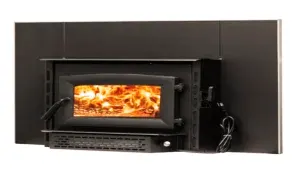


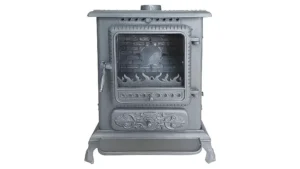



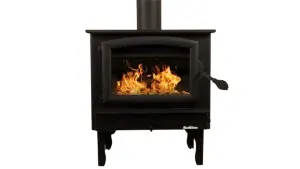


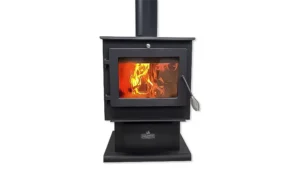
Hi... are you an American company? Does all the measurements apply to America??
Mr D Wyatt
November 4, 2023 6:47 pm